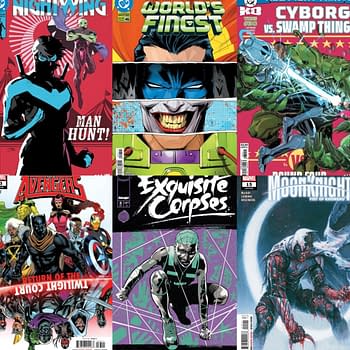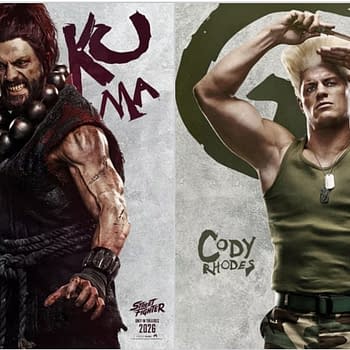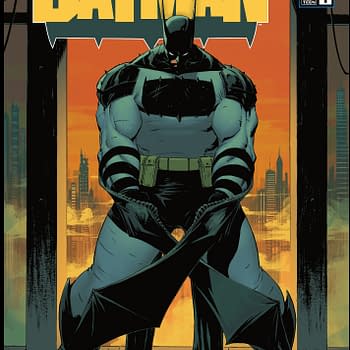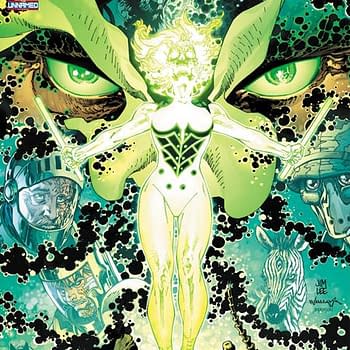Posted in: Comics | Tagged: beian bendis, Comics, image, sam and twitch
Anatomy Lesson – Sam And Twitch #1
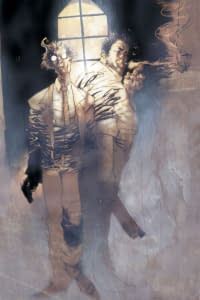
"Udaku- Chapter One" by Brian Michael Bendis and Angel Medina
Sometimes it just hits you, you know?
You're watching something or you're reading something and it is so obviously unlike anything you've seen or read before, and you know without a doubt that you're going to follow it until it doesn't exist anymore. The creative impact is so undeniable, so personally profound, that all you can think is, "Wow, am I glad I took a chance on this thing I didn't know. Where in the hell has this been and why the hell didn't I know anything about it before now?" That's how it feels, at least to me—like you've been struck by a lightning bolt, and you're both inspired and a little intimidated at the same time. Like you'll never be able to create anything that hits somebody like you've just been hit, and aspiring to do so is the only thing that even matters. I'm talking about stuff like the original Star Wars movie. Or the incredible pilot episodes for shows like The X-Files, LOST, 24, and Breaking Bad. Or in this very specific case, the first issue of Sam and Twitch written by Brian Michael Bendis.
At the time, I had absolutely no idea who he was, but anyone who's been reading really anything I've written in the last several years knows that I am a huge, huge fan of his work to this day. And that all started right here in this 22-page frame. Don't know how I even ended buying the book, was probably still reading Spawn monthly at the time, but in the end, it doesn't even matter how. Only that I did and was struck by an almost instant realization that I love how this writer goes about writing comics.
A lot of the things Bendis is now well known for is on display here in the first part of the massive Udaku storyline—the strategic use of dramatic silence, the methodical pacing and cadence, the giant spreads of talking heads, and the dialogue, oh man the great dialogue that just bounces from character to character. This entire story arc became like a clinic for me on how to enter and exit scenes at just the right point, to develop characters not only by the things they say but how they say it, and above all else, to be almost supernaturally patient when telling a story. To not throw "cool" things at the reader just because you can, or to use that approach as a cheat for masking a lack of focus on genuine character development. That if you have the time and if you have the space and if the story demands it, never be afraid to slow everything down and build things carefully and with definite purpose, before you hit 'em with that important moment you've really been building to all along. And in that is what the story was really about from the beginning.
I know some people don't like this approach (or this writer) and think his "style" is really an indictment on how different comics are in this modern, sometimes overly sophisticated age, but I think every single one of them is wrong. The problem was never how Brian Michael Bendis writes comics, the problem was that in the wake of his tremendous success people that had no business doing it were trying to imitate his work and approach, grasping at what they thought the strength of it was and very obviously missing the point. I know this well because for a while as a young almost professional writer I was doing it too, only difference is that my poor attempts at flattery weren't being published for all to see.
But I was young and stupid and inspired, and like a lot of his detractors back then…I honestly believed the true strength of his work was the dialogue. I thought that one element is what ultimately distinguished his work from his worthy peers, but again, young and stupid. It's not just the dialogue. Not really. That skill only serves to further anchor the very grounded and humanistic approach he takes when writing adventures about fantastic and amazing characters, his ability to build and plan and build some more to ensure that the larger story is more powerful than its severed chapters, and that character is everything always. And that it deserves the same care and attention and patience that comics often extends to its more colorful and exciting depictions of superhero violence. It's not really about the fight, only what caused it and the larger ramifications of it.
Here, I'll provide an example that originated directly from this first issue, which admittedly knocked me on my ass for several reasons. The bit with the identical severed body parts showing up at the crime scenes is that great hook that just won't let go, and while the ultimate reveal is cool and scary and great on its own, to me the moment that makes this entire story work is a couple issues down the road when Sam Burke confronts his best friend about the terrible things Twitch said about him behind his back. Sure, it was a complete set-up from government elements deliberately meant to throw everyone off their game, but when comforted by a pretty face, Twitch said things he'd never have said to his friend's face. And that embarrassment and that crushing shame pouring off him when he's confronted by his friend's bruised feelings, along with his awkward revelation that his wife has left him because of his devotion to his friend, is just classic character work.
These little (yet enormous) emotional gut punches, built to over a course of issues (oftentimes several of them) is the true signature of Brian Michael Bendis' work. Not talking fucking heads. Long term, patient, and always-realistic character interaction and development.
I'm sorry some of you don't get that, but that's what it is. That's the big secret.
And after reading this first issue, it was clear to me that I'd be a huge fan of his work until he stopped making it, and since then he's written a number of my all-time favorite creative runs in comics. And it all started with Twitch Williams sitting by himself at a bar with the smoke from a cigar wafting up across the page. There's a white hat sitting in front of him and there's a story attached to it. For me, it was only the first of many great ones…
Previous Anatomy Lessons-
The Adventures of Barry Ween, Boy Genius 3: Monkey Tales #6
Sensational Spider-Man Annual #1
The Saga of the Swamp Thing #21
Brandon Thomas writes comics and writes about comics. He's written stories for Dynamite, Marvel, DC, and Arcade Comics, and co-created The Many Adventures of Miranda Mercury, with artist Lee Ferguson, which is available right now from Archaia in OGN format. His personal blog is The Fiction House, and his Twitter handle is @mirandamercury.






